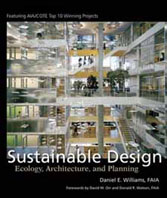| |
Current global and local challenges constitute an opportunity to give responsible answers, through design practice, to the challenges of sustainability.
Sustainable
design
Daniel E.Williams, Sustainable
design, Ecology, Architecture, and Planning, 2007
We are all nature – all changes caused within nature and habitat have an impact on us. The radical degradation of the landscape requires radical changes in the design process and in architectural practice. Rethinking the building - not as an object but as an organism with flows, a container of energy and materials - is essential for sustainability.
The primary objective is to unplug our buildings and power them only with the energy present on site. Making this concept our own, we begin the exciting process of sustainable design [...] The challenge of sustainable design is to capture, store and concentrate local renewable energy sources for the uses of the local population.
The greatest sustainable energy resource for this planet is natural energy. This energy does virtually all the work to make the planet and its places habitable and hospitable.
This work is fueled by energy sources that, in general, are not considered as such: sun, wind, water, gravity, tides and hydrological cycles. There is an immense amount of this free energy and it is the only source of sustainable energy. [...]
An organism designed for life will use, produce, store and renew resources, distill waste products and re-distribute them. [...]
[...] If twentieth century architecture was challenged to design 'machines for living', the challenge for twenty-first century architecture will be to design 'organisms for living'.
Sustainable designs are system designs. They help to resolve - simultaneously as one system – economic, social and environmental issues.
The more sustainable energy is integrated into the built environment, the more it will become sustainable.
PRINCIPLES FOR SUSTAINABLE DESIGN
1 - Design to strengthen the relationship between building, site, community and ecology. Cause minimal changes to the operation of the natural system. Strengthen and take care of the specific natural features of the place.
2 - Design with the same resources and objectives that have, for centuries, made that place sustainable.
3 - Long life, loose fit: design for future generations, respecting the teachings of past generations.
|
 |
|
|

